|
Click pictures for a larger version.
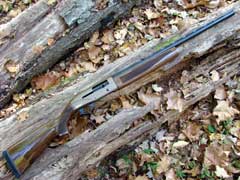
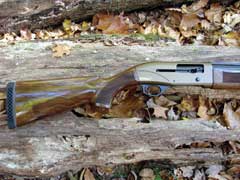
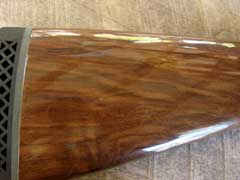
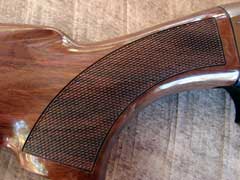
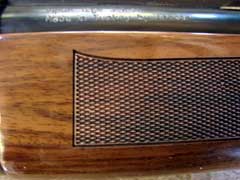
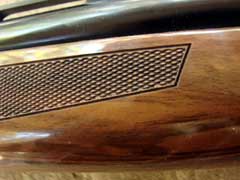
Stock and forend are beautiful checkered Turkish
walnut.
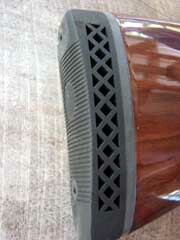
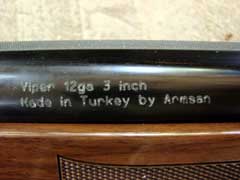
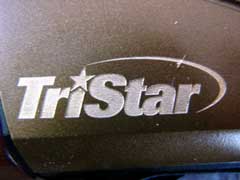
  
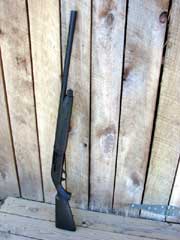
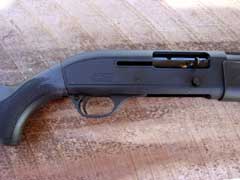
TriStar Sporting Arms 12 Gauge Semi-Auto Shotgun.
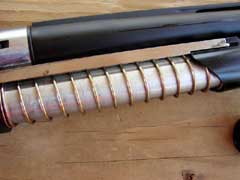
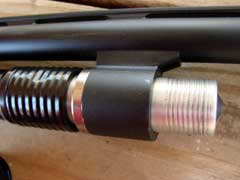
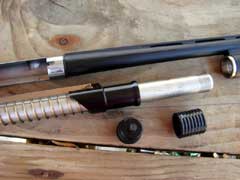
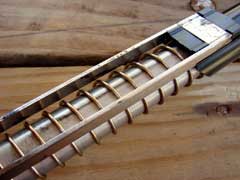
The TriStar is nicely made, with beautifully machined
metal gas system parts.
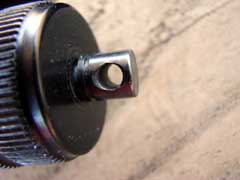
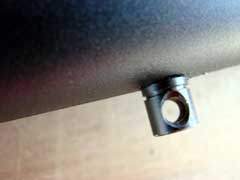
Swivel studs are factory installed.
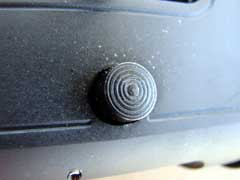
Bolt release latch is easy to operate.
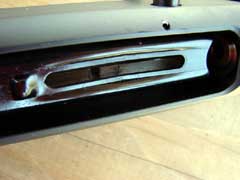
Slotted shell carrier.
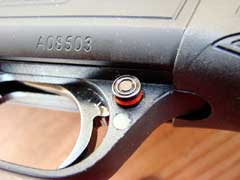
Safety is a crossbolt type, mounted behind the trigger.
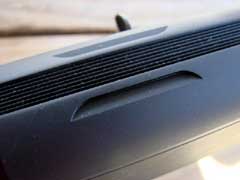
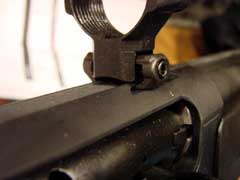
Receiver is machined for scope rings.
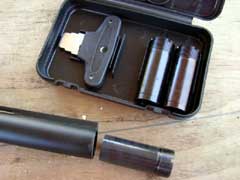
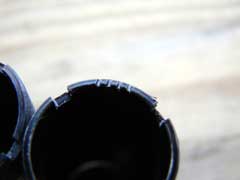
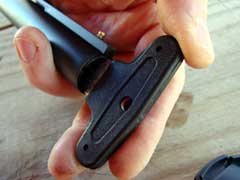
Screw-in choke tubes.
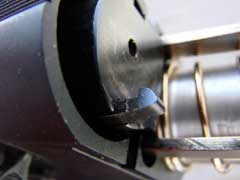
Beefy machined steel extractor helps assure positive
function.
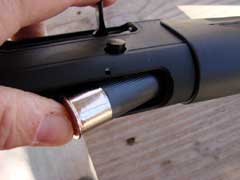
Magazine loads through the bottom of the receiver.
|
|
UPDATE! October 24th, 2015
TriStar Arms is now producing their Viper G2
line of semi-auto shotguns, available in a variety of gauges,
barrel lengths, finishes, and stock types. We recently spent
some time with the 12 gauge Viper G2 Bronze version, which
features a bronze-colored Cerakote receiver and beautiful
Turkish walnut stock and forend. The shotgun is beautiful,
affordable, and performed flawlessly.
See the entire line of TriStar firearms
online at www.tristararms.com.
To buy TriStar firearms online,
click on the GUN GENIE at www.galleryofguns.com.
  
TriStar Sporting Arms 12 Gauge Semi-Auto Shotgun
by Jeff Quinn
photography by Jeff Quinn & Boge Quinn January 21st, 2008
Hunters today demand a lot from a
shotgun. Compared to the shotguns of our fathers and
grandfathers, today’s shotguns deliver more power, heavier
payloads, faster velocities, and better patterns, all with less
recoil. The gas-operated semi-auto shotgun has been with us for
many decades now, and the designs keep getting better. I
remember when many gas guns were pretty finicky about the
ammunition that they would reliably cycle. Today, we have
semi-auto shotguns that will reliably function with a wide
variety of ammunition types within the same gauge. Most of these
twenty-first century gas guns are also pretty pricey. Some of
today’s imported gas guns sell for well over 1200 bucks, and a
lot of them sell for upwards of $1500. That is just fine if one
has the money. However, many shooters come equipped with
something called a “family”, which usually carries around
necessary expenses for things like groceries, clothes,
schooling, and a warm place to sleep. Paying out three weeks pay
for a new shotgun just isn’t possible for some hunters.
Now we are getting to the meat of this review;
the TriStar semi-auto shotgun. Up until now, I had
ignored the TriStar brand. Not intentionally, it’s just that I
didn’t think much about it. That was my mistake. Also, I am
not much of a shotgunner. I prefer the rifle and handgun, and
look at the shotgun as merely a tool. A necessary tool, but a
tool that gets the job done without a lot of fuss and tweaking,
as is sometimes necessary to achieve the potential of a rifle or
handgun. Readers sometimes gripe that I tend to ignore the
shotgun, and their accusations are true. I keep a couple of
shotguns around for hunting, and I also own a good fighting
shotgun. Still, I shoot a lot more bullets than shot.
Like most of the shotguns sold in the USA, the
TriStar is imported, and like many shotguns sold in the USA, the
TriStar is imported from Turkey. The Turks have a long history
of gun-making, and many importers are going to that country to
supply the market here in the US. I admit to a once-held
prejudice against Turkish shotguns, but that has changed over
the last several years. Some fine shotguns now come into the US
from Turkey. Some are high-dollar doubles, but some are also
built and priced to sell to a hard-working family man. Again,
there is nothing wrong with spending a handful of hundreds on a
shotgun if that is your thing, but these days, it is no longer
necessary, and spending a lot of cash on a shotgun does not
guarantee reliability. More on that later.
The shotgun tested here is as good of a design
for a gas-operated shotgun as I have seen. The gas system is
machined from steel and aluminum alloys. No small plastic parts
in this TriStar as there are in some shotguns of similar design.
The only plastic part under the forearm is the part called the
“connection rubber”, and it is a substantial piece that
serves as an action buffer. The TriStar has twin action bars,
and the bolt locks into the barrel extension. The shell carrier
is slotted, which makes life much easier if you ever manage to
get a shell under the carrier. In some designs, it means that
you have to remove the trigger group. In the TriStar, and others
with a slotted carrier, a screwdriver or pocket knife makes it
simple to push the offending shotshell forward into the magazine
tube. Like other semi-auto shotguns, the TriStar magazine tube
is loaded from the bottom. With the plug in the tube, it holds
two shells, for a total loaded capacity of three, which is
necessary for legally hunting migratory birds in the US. For
rabbits, squirrels, and quail and such, the plug is easily
removed, allowing a capacity of five. The TriStar comes supplied
with three screw-in choke tubes; improved cylinder, modified,
and full. The chokes are notched, as is customary on European
choke tubes, with notches representing the choke constriction,
and the manual contains a chart translating the notches into
relative choke constriction. Also supplied is a good,
easy-to-use choke wrench. The stock on the sample TriStar is
made of a tough synthetic, as many hunters prefer these days,
but wood is also available for those who prefer the more
traditional look. Also available are a few different camouflage
patterns, suitable for most any hunting situation where there is
a need to lay low and hide, as in water fowling. The stock is
shaped well, and has molded-in checkering for a secure grip. The
TriStar is also equipped with sling studs, which is a welcome
addition for turkey hunters. The ventilated rib barrel and
receiver are finished in a matte black. The rib measures .274
inch wide, and wears a brass bead at the muzzle. The aluminum
alloy receiver is machined atop for scope rings, making this
shotgun more suitable for turkey hunters who like an optical
sight. The push button safety is located to the rear of the
trigger, and pushes to the left to fire. I do not know whether
or not the safety is reversible for left-handed shooters, as I
have become accustomed to reaching under and pulling it to the
left on other shotguns for many years. I prefer a top tang
safety, as is found on most double guns, but that is just a
personal preference. Loading the TriStar is simple. With the
bolt locked open, drop one in the ejection port and push the
bolt latch. Then, just load the mag tube to capacity. The
trigger pull measures five and one-quarter pounds on this
TriStar, which is about right for a foul weather hunting
shotgun. The TriStar is easy to operate, even when wearing
gloves. The test gun, in twelve gauge with a twenty-eight inch
barrel weighed, in at six pounds, nine ounces. The butt pad is
slick around the edges for easy shouldering without hanging up
on clothing, and has a soft rubber insert in the middle.
The three inch magnum TriStar tested here is
advertised to shoot any two and three-quarters or three inch
shells, interchangeably without adjustment. Testing proved this
to be true. I fired the TriStar with light handloads, factory Winchester
AA target loads, AA Handicap loads, Federal Field Loads, Remington
high brass 2 ¾ inch loads, and Remington and Winchester heavy
three inch magnum turkey loads. All functioned perfectly.
Patterning with the turkey loads using the full choke indicated
that out to around forty-five yards, maybe fifty, the supplied
full choke would work just fine on turkey. Past that, an
extra-full specialty turkey choke would be preferred. For that, George
Trulock of Trulock Chokes
(1-800-293-9402) can supply any specialty choke constriction
needed. He makes good stuff.
For busting clays, the modified choke worked
well for me, and I expect that most quail hunters will find the
improved cylinder choke to be just perfect.
Now, for a bit more on the reliability of this
shotgun. As stated earlier, it worked perfectly with all ammo
tested. One complaint that I hear a lot about gas shotguns is
that they do not always work well in cold, damp weather. Around
here, duck and goose hunting is a big thing. Some of these water
fowlers drive a long way and spend a lot of money to hunt around
the Dover Bottoms, and some of them bring high-dollar European
and Japanese shotguns along. Some also bring quality American
made shotguns to the blinds. I often hear complaints of some of
these guns not working well in freezing weather, with many
hunters going back to the pump shotgun or recoil-operated autos
for better reliability, preferring to feel the extra recoil of
these guns over the softer shooting but less reliable gas guns.
I wanted to see if the TriStar would or would not function in
wet, freezing conditions, so I decided to freeze it and see for
myself. No matter what the price, a shotgun is worthless if it
doesn’t work. I left the shotgun outside for two days, with
the overnight temperature dipping to only six degrees. To me,
that is cold. Too cold. I periodically sprayed the frozen gun
down with water, forming a sheet of ice over the entire shotgun.
The forearm does a pretty good job of sealing the gas system
from the elements. As can be seen in the video,
even frozen, the TriStar still keeps shooting. I wasn’t sure
if it would or would not, but the shotgun fired as designed. The
ammo had also been left out in the cold, loaded inside the
shotgun, with one in the chamber and two in the tube, just as it
would be in a hunting situation. The safety pressed off easily,
breaking away a little ice in the process. The trigger pulled,
and the gun fired and cycled as designed. I like that.
This TriStar has proven itself reliable,
well-balanced, soft-shooting, and easy to operate. Now for the
best part; the TriStar is also affordable to almost everyone.
The MSRP on the test gun, at the time of this writing, is just
under 400 bucks. Real world gun shop prices are usually even
less. This shotgun costs about one-third the price of some
famous-name imported gas guns, and is more reliable than many of
them, and just as reliable as the best. Admittedly, this is the
first TriStar shotgun that I have ever tested, but hopefully, it
won’t be my last. I am anxious to try out their
shorter-barreled camo turkey gun, as Spring will be here soon.
Look at the entire line of TriStar firearms
online at www.tristararms.com.
To buy TriStar firearms online,
click on the GUN GENIE at www.galleryofguns.com.
Jeff Quinn
  
Got something to say about this article?
Want to agree (or disagree) with it? Click the following link to
go to the GUNBlast Feedback Page.
|
|
Click pictures for a larger version.
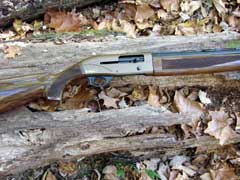
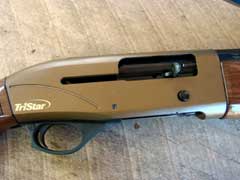
Aluminum receiver is finished in bronze Cerakote.
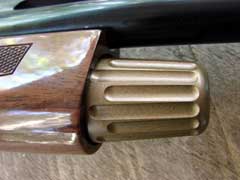
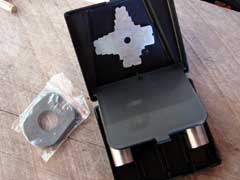
Included are stock shims, choke wrench, and
Beretta-style choke tubes in Improved Cylinder, Modified, and
Full.
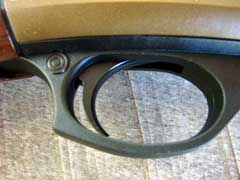
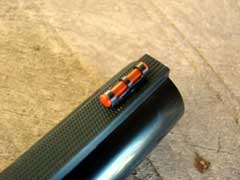
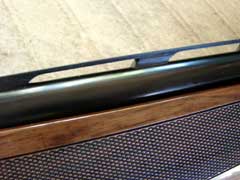
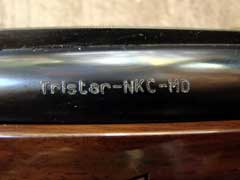
  
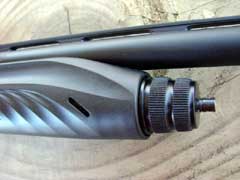
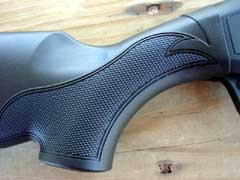
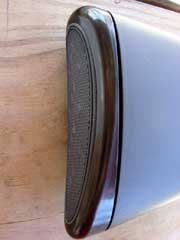
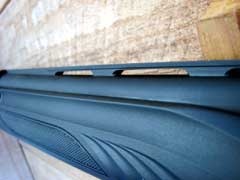
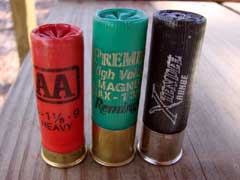
The TriStar functioned
perfectly with a variety of loads, from light target
through 3 inch magnum turkey loads.
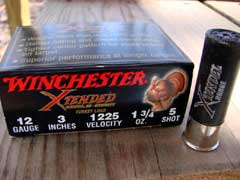
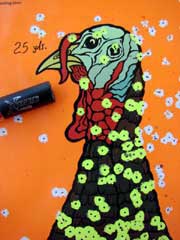
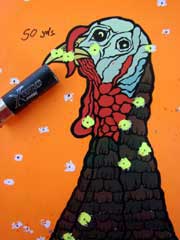
The TriStar would be an affective
turkey gun out to 50 yards.
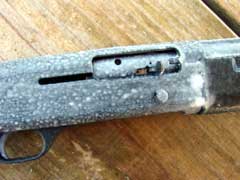
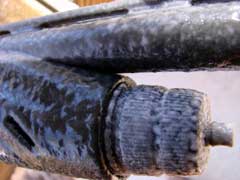
Author tested the TriStar in
freezing cold conditions, coated in a layer of ice.
Functioning was perfect, as can be seen in the video. 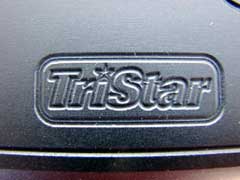
|
![]()